| Revision as of 13:02, 26 September 2013 editകാർത്തുമ്പി (talk | contribs)491 edits Disambiguated: masala → Spice mix (2)← Previous edit | Revision as of 05:36, 29 September 2013 edit undoAnarchistdy (talk | contribs)438 edits fixed quoteNext edit → | ||
| Line 128: | Line 128: | ||
| {{Main|Anglo-Indian cuisine}} | {{Main|Anglo-Indian cuisine}} | ||
| ], a popular breakfast dish in the ].]] | ], a popular breakfast dish in the ].]] | ||
| ], a modified version of Indian ]. It has been called " |
], a modified version of Indian ]. It has been called "A true British national dish." <ref name=Guardian>{{cite news |url=http://www.guardian.co.uk/world/2001/apr/19/race.britishidentity|title=Robin Cook's chicken tikka masala speech |publisher=''The Guardian'' |accessdate=2001-04-19 | date=2002-02-25 | location=London}}</ref> | ||
| ] is the most popular alternative to traditional cooking in Britain, followed by ] and ] food.<ref>{{cite web |url=http://www.menu2menu.com/italfigs.html |title=Italian Food : Facts, Figures, History & Market Research |accessdate=2008-01-31}}</ref><ref>{{cite web |url=http://www.caterersearch.com/Articles/2005/06/27/301079/market-snapshot-ethnic-food.html |title=Caterersearch : Market snapshot - Ethnic food |accessdate=2008-01-31}}</ref> The chicken tikka masala is now considered one of Britain's most popular dishes.<ref>{{cite news|url = http://news.bbc.co.uk/1/hi/scotland/glasgow_and_west/8161812.stm|title = Popular British dishes|accessdate = 2010-02-18 | work=BBC News | date=2009-07-21}}</ref> | ] is the most popular alternative to traditional cooking in Britain, followed by ] and ] food.<ref>{{cite web |url=http://www.menu2menu.com/italfigs.html |title=Italian Food : Facts, Figures, History & Market Research |accessdate=2008-01-31}}</ref><ref>{{cite web |url=http://www.caterersearch.com/Articles/2005/06/27/301079/market-snapshot-ethnic-food.html |title=Caterersearch : Market snapshot - Ethnic food |accessdate=2008-01-31}}</ref> The chicken tikka masala is now considered one of Britain's most popular dishes.<ref>{{cite news|url = http://news.bbc.co.uk/1/hi/scotland/glasgow_and_west/8161812.stm|title = Popular British dishes|accessdate = 2010-02-18 | work=BBC News | date=2009-07-21}}</ref> | ||
Revision as of 05:36, 29 September 2013

| British cuisine |
|---|
 |
| National cuisines |
| Regional cuisines |
| Overseas/Fusion cuisine |
| People |
|
|
| Culture of England |
|---|
 |
| History |
| People |
| Languages |
| Traditions |
| Mythology and folklore |
| Cuisine |
| Festivals |
| Religion |
| Art |
| Literature |
| Music and performing arts |
| Media |
| Sport |
| Monuments |
| Symbols |
English cuisine encompasses the cooking styles, traditions and recipes associated with England. It has distinctive attributes of its own, but also shares much with wider British cuisine, largely due to the importation of ingredients and ideas from places such as North America, China, and India during the time of the British Empire and as a result of post-war immigration.
In the Early Modern Period the food of England was historically characterised by its simplicity of approach and a reliance on the high quality of natural produce. It is possible the effects of this can still be seen in traditional cuisine.
Traditional meals have ancient origins, such as bread and cheese, roasted and stewed meats, meat and game pies, boiled vegetables and broths, and freshwater and saltwater fish. The 14th-century English cookbook, the Forme of Cury, contains recipes for these, and dates from the royal court of Richard II. In the second half of the 18th century Rev. Gilbert White, in The Natural History of Selborne made note of the increased consumption of vegetables by ordinary country people in the south of England, to which, he noted, potatoes had only been added during the reign of George III: "Green-stalls in cities now support multitudes in comfortable state, while gardeners get fortunes. Every decent labourer also has his garden, which is half his support; and common farmers provide plenty of beans, peas, and greens, for their hinds to eat with their bacon."
Other meals, such as fish and chips, which were once urban street food eaten from newspaper with salt and malt vinegar, and pies and sausages with mashed potatoes, onions, and gravy, are now matched in popularity by curries from India and Bangladesh, and stir-fries based on Chinese and Thai cuisine. Italian cuisine and French cuisine are also now widely adapted. Britain was also quick to adopt the innovation of fast food from the United States, and continues to absorb culinary ideas from all over the world while at the same time rediscovering its roots in sustainable rural agriculture.
Foods and ingredients
Bread
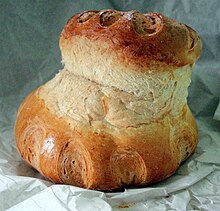
There is a wide variety of traditional breads in Great Britain, often baked in a rectangular tin. Round loaves are also produced, such as the North East England speciality called a stottie cake. A cottage loaf is made of two balls of dough, one on top of the other, to form a figure-of-eight shape. A cob is a small round loaf. There are many variations on bread rolls, such as baps, barms, breadcakes and so on. The Chorleywood process for mass-producing bread was developed in England in the 1960s before spreading worldwide. Mass-produced sliced white bread brands such as Wonderloaf and Mother's Pride have been criticised on grounds of poor nutritional value and taste of the loaves produced. Brown bread is seen as healthier by many, with popular brands including Allinson and Hovis. Artisanal baking has also seen a resurgence since the 1970s.
Rye bread is mostly eaten in the form of Scandinavian-style crisp bread, such as that produced by Ryvita in Birmingham. Malt loaf is a dark, heavy and sweet bread. The popularity of Indian cuisine in Britain means that Indian breads such as naan are made and eaten there. Continental varieties, such as baguettes (also known as "French sticks") and focaccia are also made. The consumption of bagels is no longer restricted to the Jewish community.
Cheese
The English Cheese Board states that there are over 700 varieties of English cheese. English cheese is generally hard, and made from cows' milk. Cheddar cheese, originally made in the village of Cheddar, is by far the most common type, with many variations. Tangy Cheshire, salty Caerphilly, Sage Derby, Lancashire Cheese, Red Leicester, creamy Double Gloucester and sweet Wensleydale are some traditional regional varieties. Cheddar and the rich, blue-veined Stilton have both been called the king of English cheeses. Cornish Yarg is a successful modern variety. The name 'Cheddar cheese' has become widely used internationally, and does not currently have a protected designation of origin (PDO) under European Union law. However West Country farmhouse Cheddar has been awarded a PDO. To meet this standard the cheese must be made in the traditional manner using local ingredients in one of the four designated counties of South West England: Somerset, Devon, Dorset, or Cornwall.
Sheep and goat cheeses are made chiefly by craft producers. Cottage cheese is a generic soft cheese style, originally home made, but now bought ready made. An Indian relative of cottage cheese, paneer is readily available, as is philadelphia cream cheese. Soft processed cheeses, such as dairylea triangles are made as a sandwich filling. Continental styles such as Brie and Camembert are sometimes also manufactured.
Popular cheese-based dishes include macaroni and cheese and cauliflower cheese.
Fish and seafood
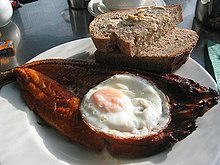
Although a wide variety of fish are caught in British waters, only a few species are widely eaten. Cod, haddock, plaice, huss, and skate are the fish-and-chip shop favourites. (The unadventurous approach and the tendency to eat fish battered were mocked by Keith Floyd with the phrase "unidentified frying objects"). A few other species, such as coley and pollock are found in the anonymous form of breadcrumbed fishcakes and fish fingers. Currently, however, other less-known fish such as ling, gurnard and turbot are becoming more widely available in an effort to preserve dwindling stocks of heavily fished species such as cod and haddock. These sustainable fish are more readily available in independent fishmongers than in supermarkets.
Pilchards (large sardines), feature in the Cornish speciality, Stargazy Pie. Otherwise, a typical fish pie consists of white fish and prawns in white sauce topped with mashed potato. Whitebait, the young of a number of species, are traditionally eaten fried as a starter. Sardines, pilchards and mackerel are often seen in tinned from, as are imported species such as tuna and anchovies. Sea bass, lobster, scallops and monkfish are among the expensive and highly-esteemed species that may be found in fine dining menus and fishmongers. Cheap fish species and fish offcuts are made into a hearty fish soup, recipes of which vary widely. Salmon, haddock, mackerel or herring may be smoked, the last in the form of kippers, buckling or bloaters. Herring may also be served pickled as rollmops. Salmon and trout are the most popular freshwater fish. Eels were once baked into pies and served with a herb sauce or "liquor" at pie and mash shops in urban working-class areas, but the dish and the shops are now both near extinction. Popular non-English fish dishes include Scottish cullen skink soup, Spanish paella, French fish soup, Thai fishcakes, moules frites and various Asian prawn dishes.
A kipper is a whole herring that has been split from tail to head, gutted, salted or pickled, and cold smoked. They are often eaten for breakfast. Smoked haddock is also eaten for breakfast in kedgeree, although this dish is now eaten at other meals as well. Other widely eaten smoked fish include salmon, mackerel, trout, haddock and eel.
Shellfish

Many seaside towns have shellfish stalls located at the beach, harbour, or seafront. Traditionally these sell snack-sized pots of cockles, mussels, jellied eels, shell-on or peeled prawns, crab meat, whelks, winkles (small and large sea snails) and oysters. The shellfish are served cold and the customer adds condiments — salt, pepper, lemon juice, malt vinegar, Worcestershire sauce, cocktail sauce or tabasco — to taste. Many stalls make their own chilli vinegar by infusing chillis in malt vinegar. In recent years, surimi and Mediterranean squid and octopus preparations have been added to the menu. Mobile shellfish stalls sometimes set up near inland pubs, particularly in London's East End.
Oysters, once a mainstay of the poor, were baked in a savoury pudding with beef. As they became more expensive, they were replaced with kidneys to form the traditional dish steak and kidney pudding. Oyster bars are now an upmarket variation on the seafood stall. Whitstable in Kent is noted as a source of good quality oysters. Oyesters are now almost always eaten raw, fresh from the shell. Crab is traditionally eaten cold in salads or sandwiches, or cooked with cream, onion and herbs and served hot in its shell. Cromer in Norfolk is a famous exporter of crab. Morecambe in Lancashire is renowned for its potted shrimps.
Pies, pastries and savoury puddings

The English tradition of meat pies dates back to the Middle Ages, when an open top pie crust was used as the container for serving the meat and was called a coffyn. Since then, they have been a mainstay of English cooking. Different types of pastry are used, including shortcrust and puff. Lard-rich hot water pastry is used for cold, raised pies, such as the pork pie, with the Melton Mowbray pork pie being the archetype. Cutting pie is a very large raised pie eaten cold in slices, which generally contains two or more meats such as chicken, ham and game. Traditional fillings for hot pies include chicken and mushroom, steak and ale, minced beef and onion, lamb, mixed game or meat and potato. In recent years, more exotic fillings, such as balti curry have appeared.
Pasties are pies made by wrapping a single piece of pastry round the filling. The Cornish pasty is oval or crescent shaped with a stiff, crimped rim, traditionally filled with beef, and swede, although many variations are possible. Other pasties may be rectangular and filled with beef, cheese, or vegetables. Another type of pie is topped with mashed potato instead of pastry – cottage pie (made with minced beef), shepherd's pie (made with minced lamb) and fish pie using a choice of several fish in white sauce. Open pies or flans are generally served for dessert with fillings of seasonal fruit. Quiches and savoury flans are eaten, but not considered indigenous.
Savoury puddings are made with a soft suet casing, the most famous being steak and kidney pudding (originally steak and oyster). For these, a pudding bowl is lined with suet crust pastry, a filling is added and a lid of pastry tightly seals it in. The pudding is then steamed for three to four hours. In addition to steak and kidney, numerous fillings can be used, including rabbit, chicken or game.
Sausages

English sausages are colloquially known as "bangers". They are distinctive in that they are usually made from fresh meats and rarely smoked, dried, or strongly flavoured. Following the post World War II period, sausages tended to contain low-quality meat, fat, and rusk. However, there has been a backlash in recent years, with most butchers and supermarkets now selling premium varieties.
Pork and beef are by far the most common bases, although gourmet varieties may contain venison, wild boar, etc. There are particularly famous regional varieties, such as the herbal Lincolnshire, and the long, curled Cumberland with many butchers offering their own individual recipes and variations often handed down through generations, but are generally not made from cured meats such as Italian selections or available in such a variety as found in Germany.
Most larger supermarkets in England will stock at least a dozen types of English sausage: not only Cumberland and Lincolnshire but often varieties such as pork and apple, pork and herb; beef and stilton; pork and mozzarella, and others. There are estimated to be around 400 sausage varieties in the United Kingdom.
Sausages form the basis of toad in the hole, where they are combined with Yorkshire pudding batter and baked in the oven. This can be served with an onion gravy made by softening onions on a low heat on a low heat then mixing with a stock, wine or ale before reducing to form a sauce or gravy used in bangers and mash. Sausages can also be wrapped in pastry to form a sausage roll, which can be served hot or cold. Slices of cold sausage roll are a popular snack food served at parties.
- Black puddings and white puddings
A variant of the sausage is the black pudding, strongly associated with Lancashire similar to the French boudin noir or the Spanish Morcilla. It is made from pig's blood, in line with the adage that "you can eat every part of a pig except its squeal", and is often eaten for breakfast. Pig's trotters, tripe and brawn are also traditional fare in the North. There are also hog's puddings (originating in Devon and Cornwall) and white puddings, similar but lacking blood.
Salted, smoked, pickles, preserves and condiments
Northern European countries generally have a tradition of salting, smoking, pickling and otherwise preserving foods. Kippers, bloaters, ham, and bacon are some of the varieties of preserved meat and fish known in England. Onions, cabbage and some other vegetables may be pickled. Meats other than pork are generally not cured.
Pickles and preserves are given a twist by the influence of the British Empire. Thus, the repertoire includes chutney as well as Branston or "brown" pickle, piccalilli, pickled onions and gherkins. Pickled eggs are traditionally sold in fish and chips shops and pickled walnuts are traditionally served with an English blue cheese such as Stilton or cooked in with beef. The Asian influence is also present in condiments such as tomato sauce (originally ketjap), Worcestershire sauce and "brown" sauce (such as HP). Because Britain is a beer-drinking nation, malt vinegar is commonly used. English mustard is strongly flavoured and bright yellow; served with meats and cooked with cheese; internationally noted for its pungency; and particularly associated with Colman's of Norwich. Pickles often accompany a selection of sliced, cold cooked meats, or "cold collation". This dish can claim to have some international influence, since it is known in French as an "assiette anglaise".
Sandwiches
England can claim to have given the world the word "sandwich", although the eponymous John Montagu, 4th Earl of Sandwich was not the first to add a filling to bread . English sandwiches are made with two slices of bread, or some kind of roll. Fillings such as pickled relishes and Gentleman's Relish could also be considered distinctively English. Common types of sandwich are roast beef, chicken salad, ham and mustard, cheese and pickle, BLT, egg mayonnaise, prawn mayonnaise, tuna, marmite and jam. Robust sandwiches made from thick slices are called "doorstops" and are often served in pubs.
Meals
Meals in England include: breakfast, elevenses, brunch, lunch, afternoon tea, dinner, and supper.
Breakfast
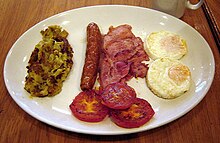
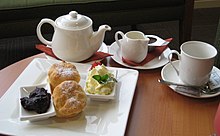
A light breakfast might consist of breakfast cereal, muesli, boiled or scrambled eggs, toast and conserves or sometimes poached kippers. Continental breakfasts and porridge are also eaten. In the 18th and 19th centuries, the upper classes ate elaborate breakfasts including such dishes as kedgeree and devilled kidneys. Now, the substantial breakfast is the full English breakfast or 'fry-up'.
A traditional full English breakfast includes bacon (traditionally back bacon, less commonly streaky bacon), poached, fried or scrambled eggs, fried or grilled tomatoes, fried mushrooms, fried bread or toast with butter, sausages and black pudding, usually served with a mug of tea. It can even be a multi-course meal, with lighter breakfast ingredients such as fruit or cereal being eaten as a starter to the fry-up. As nearly everything is fried in this meal, it is commonly called a "fry-up". When an English breakfast is ordered to contain everything available it is often referred to as a Full English, or a Full Monty. Full English breakfasts are usually consumed in the home on non-working days, when there is enough time to prepare them, or at a hotel or cafe, They can also be enjoyed at lunchtime or as a late supper. Some eateries specialise in the "all day breakfast", and serve almost nothing else.
Afternoon tea
Main article: TeaIt is a widespread stereotype that the English "drop everything" for a teatime meal in the mid-afternoon. This is no longer the case in the workplace, and is rarer in the home than it once was. A formal teatime meal is now often an accompaniment to tourism, particularly in Devon and Cornwall, where comestibles may include scones with jam and clotted cream (together known as a cream tea). There are also fairy cakes, simple small sponge cakes which can be iced or eaten plain. Nationwide, assorted biscuits and sandwiches are eaten. Generally, however, the teatime meal has been replaced by snacking, or simply dispensed with.
The Sunday roast
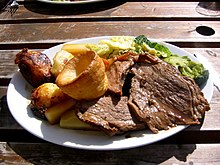
The Sunday roast was once the most common feature of English cooking. It is traditionally eaten every Sunday. It includes roast potatoes accompanying a roasted joint of meat such as beef, lamb, pork, duck or chicken and assorted other vegetables, themselves generally boiled and served with a gravy or roasted with the meat in its juices, which are then used as or added to the gravy. Sauces and jellies are chosen depending on the type of meat: horseradish or various mustards for beef, mint sauce or redcurrant jelly for lamb, apple sauce for pork and cranberry sauce for turkey. Yorkshire pudding normally accompanies beef (although traditionally served in Yorkshire as a starter, from the days when meat was scarce so was served first as a "filler" ), sage and onion stuffing for pork and usually parsley stuffing for chicken. Gravy is made from giblets or the meat juices in the pan by adding water, stock or wine.
Game meats such as venison and pheasant which were traditionally the domain of higher classes are occasionally also eaten by those wishing to experiment with a wider choice of foods, due to their promotion by celebrity chefs, although they are not usually eaten frequently in the average household. Game is only available from September to February unless farmed.
The practice of serving a roast dinner on a Sunday is related to the elaborate preparation required, and to the housewife's practice of performing the weekly wash on a Monday, when the cold remains of the roast made an easily assembled meal. Sunday was once the only rest day after a six-day working week; it was also a demonstration that the household was prosperous enough to afford the cost of a better than normal meal.
An elaborate version of the roast dinner is traditionally eaten at Christmas, with almost every detail rigidly specified by tradition. Since its widespread availability after World War II the most popular Christmas roast is turkey, superseding the goose of Dickens's time. This is served with the usual accompaniments, as well as trimmings such as pigs in blankets, sausagemeat and sometimes Yorkshire pudding. Before the period of cheap turkeys, roast chicken would be more common than goose although chicken was still a once a year treat until the 1950s, goose being unsuitable for small groups of diners. Today goose is still occasionally eaten at Christmas, traditionally served with roast apples stuffed with sausagemeat.
Dessert

Traditional desserts are generally served hot and are highly calorific. There are a number are variations on suet pudding, and "pudding" is the usual name for the dessert course in England.
Suet puddings include Jam Roly-Poly, and spotted dick. Summer pudding and bread and butter pudding are based on bread. Sponge cake is the basis of sticky toffee pudding and treacle sponge pudding. Crumbles such as rhubarb crumble have a crunchy topping over stewed fruit. Other traditional hot desserts include apple pie, treacle tart, Gypsy tart. Eton mess and trifle are served as cold desserts.
There is also an elaborate dried fruit based Christmas pudding, and the almond flavoured Bakewell tart originating from the town of Bakewell. Banoffee pie now known internationally was invented by a Sussex restauranteur in the 1970s.
Traditionally, many desserts are accompanied by custard or cream, clotted or whipped.
Savoury course
Another English culinary tradition, rarely observed today, is the consumption of a savoury course toward the conclusion of a meal. This now though may be eaten as a snack or a light lunch or supper. Most meals today end with a sweet dessert, although cheese and biscuits may be consumed as an alternative or as an addition. When a cheese course is eaten, it is always after the dessert. In Yorkshire, fruit cake is often served with Wensleydale cheese, as is apple pie. Coffee can sometimes be a culminatory drink.
Food establishments
Pub food

Traditionally pubs in England were drinking establishments and little emphasis was placed on the serving of food, other than "bar snacks", such as pork scratchings, and pickled eggs, along with salted crisps and peanuts which helped to increase beer sales. If a pub served meals they were usually basic cold dishes such as a ploughman's lunch. In South East England (especially London) it was common until recent times for vendors selling cockles, whelks, mussels and other shellfish, to sell to customers during the evening and at closing time. Otherwise, pickled cockles and mussels may be offered by the pub in jars or packets.
In the 1950s some British pubs would offer "a pie and a pint", with hot individual steak and ale pies made easily on the premises by the landlord's wife. In the 1960s and 1970s this developed into the then-fashionable "chicken in a basket", a portion of roast chicken with chips, served on a napkin, in a wicker basket. Quality dropped but variety increased with the introduction of microwave ovens and freezer food. "Pub grub" expanded to include British food items such as steak and ale pie, steak and kidney pudding, shepherd's pie, fish and chips, bangers and mash, Sunday roast, ploughman's lunch, and pasties. In addition, dishes such as burgers, lasagne and chili con carne are often served. Some pubs offer hot and cold snacks free to customers on Sunday lunchtimes to prevent them getting hungry and leaving for their lunch at home.
Since the 1990s food has become more important as part of a pub's trade, and today most pubs serve lunches and dinners at the table in addition to (or instead of) snacks consumed at the bar. They may have a separate dining room. Some pubs serve meals to a higher standard, to match good restaurant standards; these are sometimes termed gastropubs.
Chip shops and other takeaways

England is internationally famous for its fish and chips and has a large number of restaurants and take-away shops selling this dish. It may be the most popular and identifiable English dish. In some regions fish and chips were served with a side order of mushy peas with salt and vinegar as condiments. Foods such as deep fried breaded scampi are usually on offer as well as fishcakes and a number of other combinations. The advent of take-away foods during the Industrial Revolution led to foods such as fish and chips, mushy peas, and pie and mash. These were the staples of the UK take-away business, and indeed of English diets, however, like many national dishes, quality can vary drastically from the commercial or mass-produced product to an authentic or homemade variety using more carefully chosen ingredients.
International and fusion cuisine
Indian and Anglo-Indian cuisine
Main article: Anglo-Indian cuisine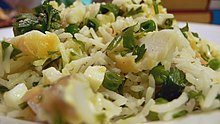
[[File:Chicken tikka masala.jpg|right|thumb|Chicken tikka masala, a modified version of Indian chicken tikka. It has been called "A true British national dish." Indian cuisine is the most popular alternative to traditional cooking in Britain, followed by Chinese and Italian food. The chicken tikka masala is now considered one of Britain's most popular dishes.
Indian food was served in coffee houses from 1809, and cooked at home from a similar date as Mrs Beeton's cookbook attests. There was a sharp increase in the number of curry houses in the 1940s and again in the 1970s.
In the Victorian era, during the British Raj, Britain first started borrowing Indian dishes, creating Anglo-Indian cuisine. Kedgeree and Mulligatawny soup are traditional Anglo-Indian dishes. The word curry, meaning 'gravy', has been used since the medieval period. The word "curry" is not used in India. Instead, "masala" is used. Currys tend to refer to light, often coloured, spiced sauces on solid food. Curry does not usually contain meat (though it may be on it), unlike gravy.
Anglo-Indian fusion food continued to develop with chicken tikka masala in the 1960s and Balti in the 1980s, although some claim the latter has roots in the subcontinent.
Home-cooked curries by ethnically English people are often based on ready made curry powder sauces or pastes, with only a minority grinding and mixing their own spice masalas. Curries are sometimes home-cooked to use up leftovers.
In 2003, there were as many as 10,000 restaurants serving Indian cuisine in England and Wales alone. It is commonly mistaken that the majority of Indian restaurants in Britain are run by entrepreneurs of Indian origin, when in fact they are predominantly Bangladeshi and Pakistani. According to Britain's Food Standards Agency, the Indian food industry in the United Kingdom is worth £3.2 billion, accounts for two-thirds of all eating out, and serves about 2.5 million British customers every week.
Indian restaurants typically allow the diner to combine a number of base ingredients — chicken, prawns or "meat" (lamb or mutton) — with a number of curry sauces — from the mild korma to the scorching phall — without regard to the authenticity of the combination. The reference point for flavour and spice heat is the Madras curry sauce (the name represents the area of India where restauranteurs obtained their spices rather than an actual dish). Other sauces are either prepared from scratch, or are variations on a basic curry sauce: for instance, vindaloo is often rendered as lamb in a Madras sauce with extra chilli, rather than the original pork marinated in wine vinegar and garlic.
In addition to curries. all restaurants offer "dry" tandoori and tikka dishes of marinated meat or fish cooked in a special oven, and biriani dishes, where the meat and rice are mixed together. Samosas, Bhajis and small kebabs are served as starters, or can be eaten by themselves as snacks.
English diners usually accompany their meals with basmati rice, bread being sometimes ordered in addition, and eat with spoon and fork. India's well-developed vegetarian cuisine is sketchily represented outside specialist restaurants.
In recent years, some Indian restaurants have started aiming higher than the norm for ethnic food, two of them garnering Michelin stars in the process.
Other
] Chinese food is well established in England, with large cities often having a Chinatown district. Predominantly derived from Cantonese cuisine, it may be so adapted to Western tastes that Chinese customers may be offered an entirely separate menu. Spare ribs in OK sauce is an example of crossover cuisine. Other South-East Asian cuisines, such as Thai, Indonesian and Vietnamese are catching up in popularity.
Italian cuisine is the most popular form of Mediterranean food, vying with Chinese and Indian food as the most popular ethnic food. Greek and Spanish restaurants are well established. Turkish tends to be associated with the take-away sector in particular late night kebab shops. Whilst Middle Eastern cooking in particular Lebanese has grown in popularity from its traditional enclaves in London.
Apart from beefburgers and hot dogs, food from the Americas tends to be represented by Mexican or Tex-mex cuisine, although there a few Creole and South American restaurants.
Caribbean and Jewish cuisine can usually only be found where there is a concentration of the community in question.
In England, French cuisine stands somewhat apart from other generally less expensive cuisine, although there are some inexpensive French bistros.
Drinks
Hot drinks
Tea
Main article: British tea culture
Catherine of Braganza, Portuguese wife of Charles II, took the Portuguese habit of tea to Great Britain around 1660, subsequent to the introduction of coffee. Initially, its expense restricted it to wealthy consumers, but the price gradually dropped, until the 19th century, when tea became as widely consumed as it is today.
In Britain, tea is usually black tea served with milk (never cream; the cream of a "cream tea" is clotted cream served on top of scones then normally strawberry jam on top, a tradition originating from Devon and Cornwall). Strong tea served with lots of milk and sometimes two teaspoons of sugar, usually in a mug, is commonly referred to in jest as builder's tea. A cup (or commonly a mug) of tea is something drunk often, with some people drinking six or more cups of tea a day.
Earl Grey tea is a distinctive variation flavoured with Bergamot. In recent years, tisanes and speciality teas have also become popular.
Coffee
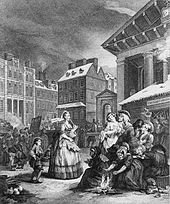
Introduced in the 17th century, coffee quickly became highly popular by the 18th century. The coffee houses of London were important literary, commercial and political meeting-places, and in some cases paved the way for the great financial institutions of 19th Century London.
Coffee is now perhaps a little less popular than in continental Europe, but is still drunk by many in both its instant and percolated forms, often with milk (but rarely with cream). Italian coffee preparations such as espresso and cappuccino and modern American variants such as the frappuccino are increasingly popular, but generally purchased in restaurants or from specialist coffee shops rather than made in the home. White sugar is often added to individual cups of tea, or brown sugar to coffee, but never to the pot.
Other
Hot chocolate and cocoa were promoted by temperance campaigners in the 19th century, and remain fairly popular. The major brands are manufactured by the Quaker-founded businesses such as Cadbury's. They are typically drunk late at night, as are Ovaltine and Horlicks.
Apple juice in its fresh pressed form, and varying stages of fermentation would be drunk, warmed and spiced in the winter time. Locally growing fruits and berry extract would also be used to flavour water with their juices. Roast dandelion root and the fresh leaves would be made into teas and tinctures and drunk for good health. Other tisanes such as rose-hip, raspberry leaf and nettle, amongst others, would also be drunk in this way.
Soft drinks
For much of the 20th century Britain had a system where fresh milk was delivered to the doorstep in reusable glass bottles in the mornings, usually by electric vehicles called "milk floats", though it has now been largely replaced by supermarket shopping. Some areas of the country still, however, enjoy door to door fresh milk to this day.
Dandelion and burdock was originally a lightly fermented beverage similar to root beer. Later versions were more artificially made and alcohol free. Soft ginger beer was popular from the late 19th to mid 20th century. Tizer and Lucozade are British carbonated drinks, the latter marketed as an energy drink. Lemonade generally refers to a clear, fizzy beverage in the UK. International brands of cola and energy drinks have become popular since the late 20th century.
Barley water, usually flavoured with lemon or other fruit, is a traditional British soft drink. It is made by boiling washed pearl barley, straining, then pouring the hot water over the rind and/or pulp of the fruit, and adding fruit juice and sugar to taste, although ready-made versions are usually consumed.
Squashes and cordials are an alternative to carbonated beverages. They are a non-alcoholic concentrated syrup that is usually fruit-flavoured and usually made from fruit juice, water, and sugar, which needs to be "diluted to taste" before drinking. Some traditional cordials also contain herbal extracts, most notably elderflower and ginger.
Alcoholic drinks
Beer and cider
See also: Beer in England and Cider § United Kingdom
England is one of the few countries where cask conditioned beer is still a major part of the market. Lager or Pilsener style beer has increased considerably in popularity since the mid 20th century, and is often used as an accompaniment to spicy ethnic food. Any kind of beer may accompany a meal in a pub. English beer cookery includes steak and ale pie and beer-battered fish and chips.
Stout is a globally known style of beer which originated in England, although it came to be associated with Ireland. It has a culinary association with oysters; they can be used to flavour stout, or it can be drunk with them.
In Britain, "cider" always means an alcoholic drink of fermented apple juice and is served by the pint or half pint like beer. It is traditionally associated with certain regions, such as the South West and Herefordshire, but commercial brands are available nationwide like Bulmers Cider and Strongbow. The cloudy, unfiltered version is called scrumpy and the related beverage made from pears is called perry. In England it is sometimes distilled into apple brandy, but this is not as widespread as with Calvados in France. Culinarily, cider is sometimes used in pork or rabbit dishes.
Wine and mead
See also: English wine
Wine often accompanies formal meals. It was introduced to England, for both production and consumption, by the Romans. Wine has been imported ever since, although it has not always been accessible to the average person.
From the Middle Ages, the English market was the main customer of clarets from Bordeaux, France, helped by the Plantagenet kingdom, which included England and large provinces in France. In the 18th century, the Methuen Treaty of 1703 imposed high duties on French wine. This led to the English becoming a main consumer of sweet fortified wines like sherry from Spain, and Port wine and Madeira wine from Portugal. Fortified wine became popular because unlike regular wine, it does not spoil after the long journey from Portugal to England. Fortified wines are used in dessert cookery, for instance sherry features as an ingredient in trifle.
By the late, 20th century wines from around the world were available to the mass market. Viticulture was restarted in the 1970s after a very long break. England is currently a major consumer, but only a very minor producer of wine, with English and Welsh wine sales combined accounting for just 1% of the domestic market.
Another form of domestic wine production is "country wines" or "fruit wines", which are made from wide variety of fruit and vegetables — elderberry, damson, parsnip and so on — other than grapes. Commercial varieties are available, but country wines are also often home-made, sometimes from garden produce or personally harvested wild fruit. Crème de cassis is made in Herefordshire.
Mead, fermented honey, was popular in the Middle Ages, but is now a curiosity.
Spirits and liqueurs
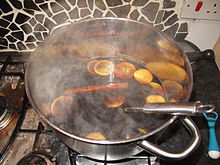
Although gin itself is not a British invention, its most popular style, London Dry Gin was developed in England. Gin and tonic has historical roots going back to the British empire, since the tonic was originally quinine taken to combat malaria in tropical climates. Rum likewise has historic associations for the English.
Whisky production in modern England restarted in Norfolk in late 2006, and the first resulting single malt whisky was made available to the public in November 2009. This was the first English single malt in over 100 years. It was produced at St George's Distillery by the English Whisky Company. Previously Bristol and Liverpool were centres of English whisky production.
Mixed drinks
An early mixed drink, dating from the 17th century punch. It is typically made of water, fruit, fruit juice and spirits and served in a large bowl to a group of drinkers. Cocktails are thought of as American, but have a British connection: Harry Craddock, a British-born US citizen invented a number of classic cocktails during his tenure at the Savoy Hotel bar. Pimms is a company which has been selling ready-mixed drinks for well over a century. Pimm's associated with the British summertime and events such as Wimbledon, the Henley Royal Regatta, and the Glyndebourne opera festival. It is often used as the basis of further mixtures including fruit, lemonade, etc.
Mixed drinks can also be based on beer (Lamb's wool) and cider (wassail).
Vegetarianism
Since the end of World War II when their numbers were around 100,000, increasing numbers of the British population have adopted vegetarianism, especially since the BSE crisis of the 1990s . As of 2003 it was estimated that there were between 3 and 4 million vegetarians in the UK, one of the highest percentages in the Western world, and around 7 million people claim to eat no red meat. The majority of restaurants will have at least one vegetarian meal on the menu.
International reputation
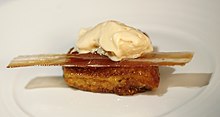
English cuisine may suffer from a relatively poor international reputation when compared to that of Italian cuisine or French cuisine. However, for many English people this perception seems outdated, for the poor reputation of industrially produced urban food in the twentieth century did not ever really represent the quality of food cooked in the home. Traditional English food, with its emphasis on 'meat-and-veg' falls squarely into the north European tradition extending from Northern Germany to the Low Countries and Scandinavia, albeit with a French influence.
During the Middle Ages and Enlightenment, English cuisine enjoyed an excellent reputation; its decline can be traced back to the move away from the land and increasing urbanisation of the populace during the Industrial Revolution. During this process Britain became a net importer of food. British food suffered heavily from effects of rationing during two World Wars, and the end of food rationing in 1954 was followed by an increasing trend toward industrialised mass production of food. However, in Britain today there is a renewed interest in the culture of food, popularly led by celebrity chefs who seek to raise the standard of food understanding in the UK.
In 2005, 600 food critics writing for the British Restaurant magazine named 14 British restaurants among the 50 best restaurants in the world, with the number one spot going to The Fat Duck in Bray, Berkshire and its chef Heston Blumenthal. In particular, the global reach of London has elevated it to the status of a leading centre of international cuisine. Meanwhile the heavy promotion of gastronomy as a post-industrial economic solution has led to a proliferation of very fine quality producers across the country.
Dishes
Main article: List of English dishesFor traditional foods with Protected Geographical Status under European law, see List of United Kingdom food and drink products with protected status.
Savoury dishes

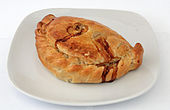
Sweet dishes


Other specialities

Food writers and chefs
Notable English food writers and chefs include:

References
- White Letter XXXVII (1778).
- British Cheese Board home page
- British Cheese Board: British Brie and Camembert
- Google News
- 50 Years of the Fish Finger
- Fearnley-Whittingstall, Hugh (2010-01-23). "Hugh Fearnley-Whittingstall's herring recipes". The Guardian. Retrieved 2012-05-06.
- Wilson, C. Anne (June 2003). Food and Drink in Britain: From the Stone Age to the 19th Century. Academy Chicago Publishers. p. 273.
- The secret life of the sausage: A great British institution
- Deutschland on line. "German Sausages". Archived from the original on 2007-12-21. Retrieved 2008-01-13.
- "UK sausages". Retrieved 2008-01-30.
- "Chip Shop restaurants in England". Lonely Planet. Retrieved 7 May 2012.
- ">A Five Star Pickled Egg Recipe, Pickling Tips and More!". Recipe4Living. Retrieved 7 May 2012.
- "Walnut recipes". BBC. Retrieved 7 May 2012.
- "Fillet steak, pickled walnuts and horseradish". BBC. Retrieved 7 May 2012.
- "Rib of beef, pickled walnuts and horseradish cream". BBC. Retrieved 7 May 2012.
- Britain's Favourite Sandwiches
- Holman, Tom (2008). A Yorkshire Miscellany. London: Frances Lincoln. p. 11. ISBN 0-711-22865-5.
- "Changing traditions". Retrieved 2007-12-11.
- "Pub Food". lookupapub.co.uk. Retrieved 26 June 2009.
- "Ploughman's Lunch - Icons of England". Icons.org.uk. 16 July 2007. Retrieved 26 June 2009.
- Better Pub Grub The Brooklyn Paper
- Pub grub gets out of pickle The Mirror
- "Robin Cook's chicken tikka masala speech". London: The Guardian. 2002-02-25. Retrieved 2001-04-19.
{{cite news}}: Italic or bold markup not allowed in:|publisher=(help) - "Italian Food : Facts, Figures, History & Market Research". Retrieved 2008-01-31.
- "Caterersearch : Market snapshot - Ethnic food". Retrieved 2008-01-31.
- "Popular British dishes". BBC News. 2009-07-21. Retrieved 2010-02-18.
- BBC: How Britain got the hots for curry
- "Cooking under the Raj". Retrieved 2008-01-30.
- "Professor says Indian eateries are experiencing a U.S. boom". University of North Texas News Service. October 13, 2003.
- "Food Standards Agency – Curry factfile".
- <"Every restaurant has a large pan of this sauce always at hand, with the recipe varying only slightly from Chef to Chef. It forms the base of all Restaurant curries from the very mild to the very hot and spicy." Khris Dillon The Curry Secret ISBN 0-710-0809-2
- "Tamarind" Michelin starred Indian restaurant
- "Amaya" Indian Restaurant
- Rayner, Jay (November 10, 2002). "The sweet and sour revolution". London: The Observer. Retrieved 2008-01-31.
- "Haute Cuisine". London: The Observer. March 9, 2003. Retrieved 2008-01-31.
- Lysaght, 1987, pp. 48–49
- Defra UK Wine Industry information
- St George's distillery
- The Vegetarian Society. "The History of vegetarianism in the UK". Retrieved 2007-10-09.
- "European Vegetarian Union". Retrieved 2007-10-09.
- "Le Cordon Bleu, London". Le Cordon Bleu. Retrieved 23 April 2012.
- Mrs Beeton's Book of Household Management
Further reading
- Ayrton, Elisabeth (1974) The Cookery of England: being a collection of recipes for traditional dishes of all kinds from the fifteenth century to the present day, with notes on their social and culinary background. London: Andre Deutsch
- Ayrton, Elisabeth (1980) English Provincial Cooking. London: Mitchell Beazley
- Grigson, Jane (1974) English Food. London: Macmillan (With illustrations by Gillian Zeiner; an anthology of English and Welsh recipes of all periods chosen by Jane Grigson, for which she was voted Cookery Writer of the Year. A revised and enlarged edition was published in 1979 (ISBN 0 33326866 0), and later editions were issued by Ebury Press with a foreword by Sophie Grigson)
- Hartley, Dorothy (1954) Food in England. London: Macdonald (reissued: London: Little, Brown, 1996, ISBN 0-316-85205-8)
External links
- Wikibooks: Cookbook: Cuisine of the United Kingdom
- George Orwell: A Nice Cup of Tea
- British Library Food Stories, a century of revolutionary change in UK food culture
- List of Michelin starred restaurants in the UK
| England articles | |||||||||||||||||
|---|---|---|---|---|---|---|---|---|---|---|---|---|---|---|---|---|---|
| History |
| ||||||||||||||||
| Geography | |||||||||||||||||
| Politics | |||||||||||||||||
| Culture |
| ||||||||||||||||
| European cuisine | |||||
|---|---|---|---|---|---|
| Sovereign states |
| ||||
| States with limited recognition | |||||
| Dependencies and other territories | |||||
| Cuisines | |||||||||||||
|---|---|---|---|---|---|---|---|---|---|---|---|---|---|
| Continental |
| ||||||||||||
| National and regional |
| ||||||||||||
| Ethnic |
| ||||||||||||
| Religious | |||||||||||||
| Historical |
| ||||||||||||
| Styles | |||||||||||||
| Lists | |||||||||||||
| Related | |||||||||||||